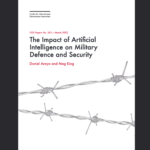Meta-Attacks: Utilizing Machine Learning to Compromise Machine Learning Systems

Table of Contents
Machine learning (ML) has swiftly infiltrated almost every aspect of our daily lives, from simplifying our online shopping experiences with personalized recommendations to driving the advent of autonomous vehicles that navigate our roads. Yet, as we become more reliant on these advanced algorithms, we also open ourselves to a host of security vulnerabilities. Enter meta-attacks, a type of cyber threat that leverages the power of machine learning against itself. Unlike conventional cyber threats, meta-attacks are specially designed to compromise existing ML systems by exploiting their inherent weaknesses. These attacks don’t just pose a risk to the data and the algorithms; they could also have broader implications on our safety, ethical norms, and even the fabric of society.
What is Machine Learning?
Machine learning is a subfield of artificial intelligence that enables computers to learn from data and improve their performance over time without explicit programming. In layman’s terms, it’s the technology that helps Netflix recommend what you should watch next or allows a self-driving car to navigate the complexities of the road. These applications make our lives easier and more efficient, but they also come with a caveat: the importance of robust security. As machine learning systems manage and analyze ever-increasing amounts of sensitive data, from personal preferences to vital health statistics, ensuring the integrity and security of these systems is paramount. Failing to do so not only risks the compromise of individual data but could also lead to broader system failures with potentially severe consequences.
Basic Types of Attacks on Machine Learning Systems
Machine learning systems are vulnerable to a variety of attacks, each exploiting specific weaknesses in the architecture or data. Data poisoning involves corrupting the training data to manipulate the system’s behavior, while adversarial attacks focus on subtly altering input data to trick the machine learning model into making incorrect predictions. Model inversion attacks seek to reverse-engineer the trained model to reveal sensitive information it has learned, and Explainable AI attacks exploit the transparency tools meant to make machine learning more understandable, using them to uncover vulnerabilities. These attacks can be combined or leveraged in a meta-attack framework, which employs machine learning to intelligently orchestrate these individual attack methods for more effective, targeted compromises of machine learning systems.
What are Meta-Attacks?
Meta-attacks represent a sophisticated form of cybersecurity threat, utilizing machine learning algorithms to target and compromise other machine learning systems. Unlike traditional cyberattacks, which may employ brute-force methods or exploit software vulnerabilities, meta-attacks are more nuanced, leveraging the intrinsic weaknesses in machine learning architectures for a more potent impact. For instance, a meta-attack might use its own machine-learning model to generate exceptionally effective adversarial examples designed to mislead the target system into making errors. By applying machine learning against itself, meta-attacks raise the stakes in the cybersecurity landscape, demanding more advanced defensive strategies to counter these highly adaptive threats.
How Do Meta-Attacks Work?
Understanding the mechanics of meta-attacks requires diving into a three-step process that involves the identification of vulnerabilities, training of secondary machine learning models, and the deployment of the attack. Here’s a closer look:
Identifying Weak Points in Target ML Systems
The first stage of a meta-attack involves comprehensive research to identify the weak points or vulnerabilities in the target machine learning system. Attackers might conduct a range of assessments, from analyzing the type of machine learning algorithm used to scrutinizing how data is processed and filtered. They can also look into previous studies or white papers that highlight potential areas of weakness in specific types of algorithms. Sometimes, attackers even use open-source versions of similar algorithms to conduct preliminary tests. The aim is to understand how the target machine-learning system might react to different kinds of manipulations.
Training a Secondary ML Model to Exploit These Weaknesses
Once the vulnerabilities are identified, the attacker moves to the second stage: training a secondary machine learning model specifically designed to exploit these weaknesses. This model serves as the “weapon” in the meta-attack. The training data for this secondary model might include a range of malicious inputs, adversarial examples, or misleading data points that are known to trigger false positives or negatives in the target system. For example, if the target is a facial recognition system, the secondary model might be trained on subtly altered images that the target system will misclassify. The sophistication of this secondary model often determines the success of the meta-attack; the better it is at exploiting the identified vulnerabilities, the more damaging the attack can be.
Deploying the Attack
The final stage involves deploying the meta-attack against the target machine learning system. This usually means feeding the manipulated or misleading data generated by the secondary model into the target system. In some cases, this could involve a straightforward data injection, while in others, it could require more complex methods, such as mimicking legitimate user behavior to bypass security measures. The goal is to compromise the integrity of the target machine learning system, be it through data corruption, erroneous predictions, or exposure to sensitive information.
In sum, meta-attacks represent a high-level threat in the ever-evolving field of cybersecurity. Their intricate methodology, which ironically uses the power of machine learning to destabilize other machine learning systems, sets them apart as particularly challenging to defend against.
Defending Against Meta-Attacks
Defending against meta-attacks requires a multi-faceted approach that goes beyond traditional cybersecurity measures. One of the first lines of defense is to employ robust machine learning algorithms that are resistant to adversarial attacks and data poisoning. Implementing anomaly detection systems can also be beneficial; these systems continuously monitor the behavior and outputs of the machine learning models to flag any irregularities, thereby offering an additional layer of security. Layered security strategies that combine multiple defenses, such as firewalls, secure data transmission, and encrypted storage, can also make it much harder for meta-attacks to succeed. Moreover, constant updating and monitoring of machine learning systems are crucial. Being aware of the latest types of attacks and continuously updating the systems to defend against them is essential for long-term security.
In addition to technical solutions, ethical guidelines and legislative measures play a significant role in mitigating the risks associated with meta-attacks. Establishing a code of ethics around the development and deployment of machine learning models can help organizations maintain integrity and accountability. Legislative initiatives can also be instrumental, imposing regulations that mandate stringent security protocols for machine learning applications, especially those handling sensitive or critical information. In this way, a combination of robust technical defenses, ethical considerations, and supportive legislation can offer a well-rounded defense against the ever-evolving threat of meta-attacks.
Recent Research on Meta-Attacks
One significant area of research involves adversarial machine learning, notably presented in [1], which dives deep into the mechanics of adversarial examples that can trick machine learning models. This concept has since been extended to meta-attacks, where machine learning is used to optimize the generation of such adversarial examples. Further, research such as [2] explores data poisoning tactics and how they can be incorporated into more complex meta-attack strategies. These studies lay the groundwork for understanding the vulnerabilities inherent in machine learning systems, thereby enabling the construction of meta-attacks.
On the defensive side, researchers focus on techniques to make machine learning models more resilient against attacks, including meta-attacks [3]. Moreover, there is growing interest in the ethical and legislative aspects of machine learning attacks. Research like in [4] discusses broad guidelines and potential policy responses to such evolving threats. These research papers collectively provide a comprehensive view of both the threats posed by meta-attacks and the potential countermeasures, capturing the current state of a rapidly evolving field.
Conclusion
Meta-attacks represent an emerging and highly sophisticated form of cybersecurity threat that leverages machine-learning techniques to compromise other machine-learning systems. These attacks pose complex challenges that demand multi-pronged solutions, from deploying robust machine learning algorithms and anomaly detection systems to incorporating ethical guidelines and legislative measures. Recent research in the field has been instrumental in shedding light on the mechanics, risks, and potential countermeasures associated with meta-attacks, thereby enabling us to better understand and mitigate these advanced threats. As machine learning continues to become more integral to our daily lives, understanding and defending against meta-attacks will be increasingly vital to ensuring the security and integrity of systems that we come to rely on.
References
- Goodfellow, I. J., Shlens, J., & Szegedy, C. (2014). Explaining and harnessing adversarial examples. arXiv preprint arXiv:1412.6572.
- Sun, G., Cong, Y., Dong, J., Wang, Q., Lyu, L., & Liu, J. (2021). Data poisoning attacks on federated machine learning. IEEE Internet of Things Journal, 9(13), 11365-11375.
- Carlini, N., & Wagner, D. (2017, May). Towards evaluating the robustness of neural networks. In 2017 ieee symposium on security and privacy (sp) (pp. 39-57). Ieee.
- Brundage, M., Avin, S., Clark, J., Toner, H., Eckersley, P., Garfinkel, B., … & Amodei, D. (2018). The malicious use of artificial intelligence: Forecasting, prevention, and mitigation. arXiv preprint arXiv:1802.07228.
For 30+ years, I've been committed to protecting people, businesses, and the environment from the physical harm caused by cyber-kinetic threats, blending cybersecurity strategies and resilience and safety measures. Lately, my worries have grown due to the rapid, complex advancements in Artificial Intelligence (AI). Having observed AI's progression for two decades and penned a book on its future, I see it as a unique and escalating threat, especially when applied to military systems, disinformation, or integrated into critical infrastructure like 5G networks or smart grids. More about me, and about Defence.AI.

Luka Ivezic
Luka Ivezic is the Lead Cybersecurity Consultant for Europe at the Information Security Forum (ISF), a leading global, independent, and not-for-profit organisation dedicated to cybersecurity and risk management. Before joining ISF, Luka served as a cybersecurity consultant and manager at PwC and Deloitte. His journey in the field began as an independent researcher focused on cyber and geopolitical implications of emerging technologies such as AI, IoT, 5G. He co-authored with Marin the book "The Future of Leadership in the Age of AI". Luka holds a Master's degree from King's College London's Department of War Studies, where he specialized in the disinformation risks posed by AI.
































































